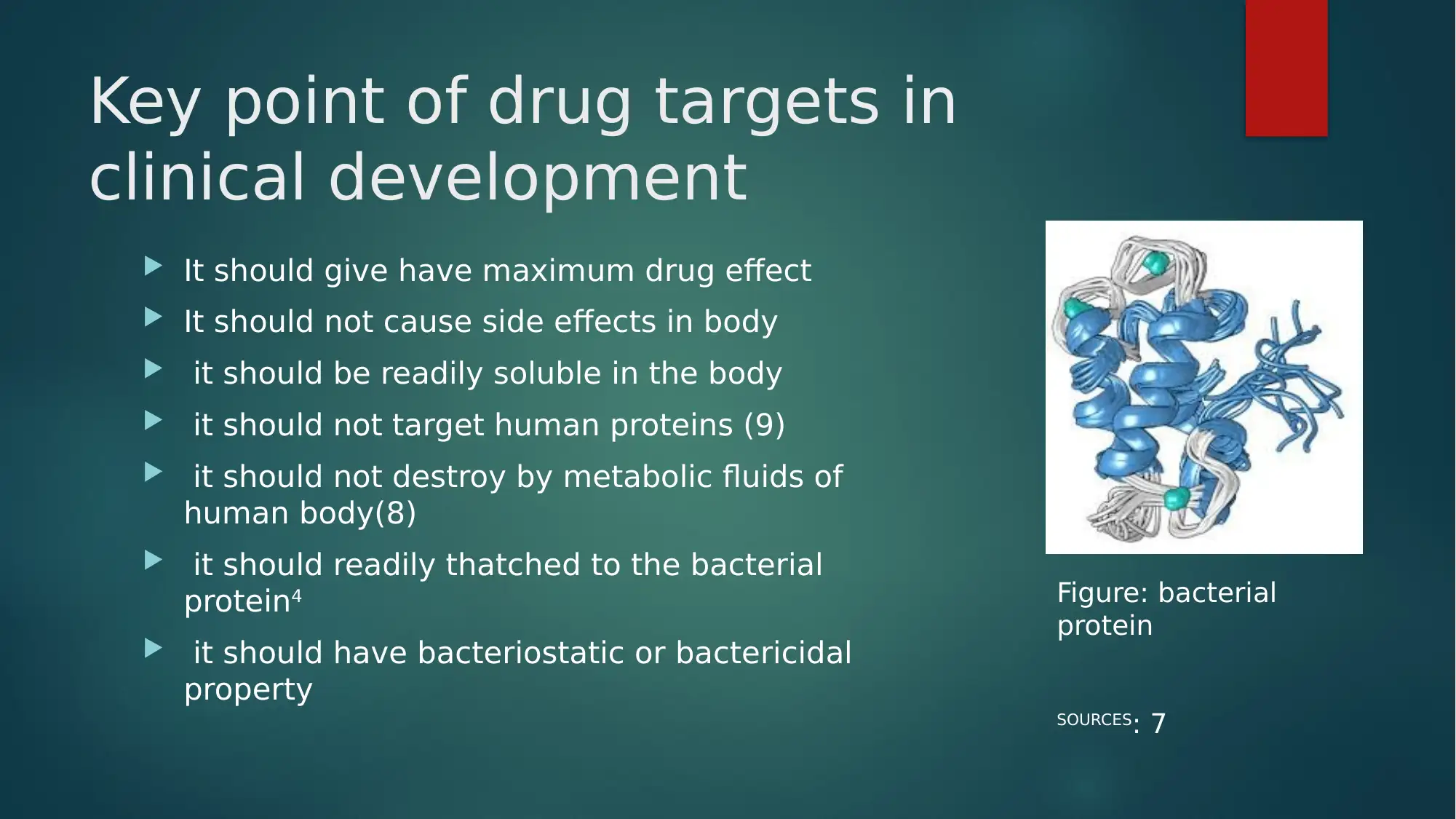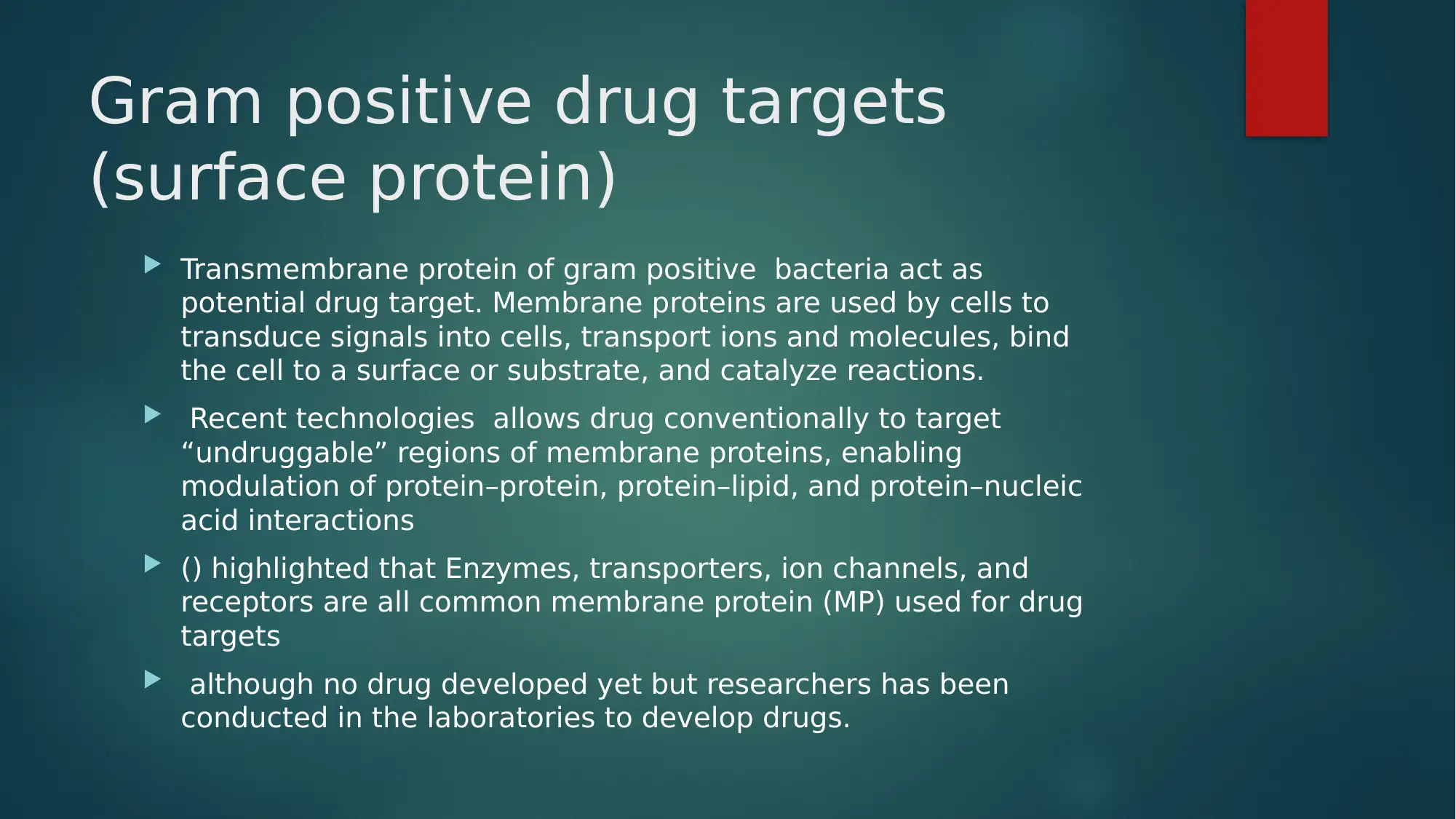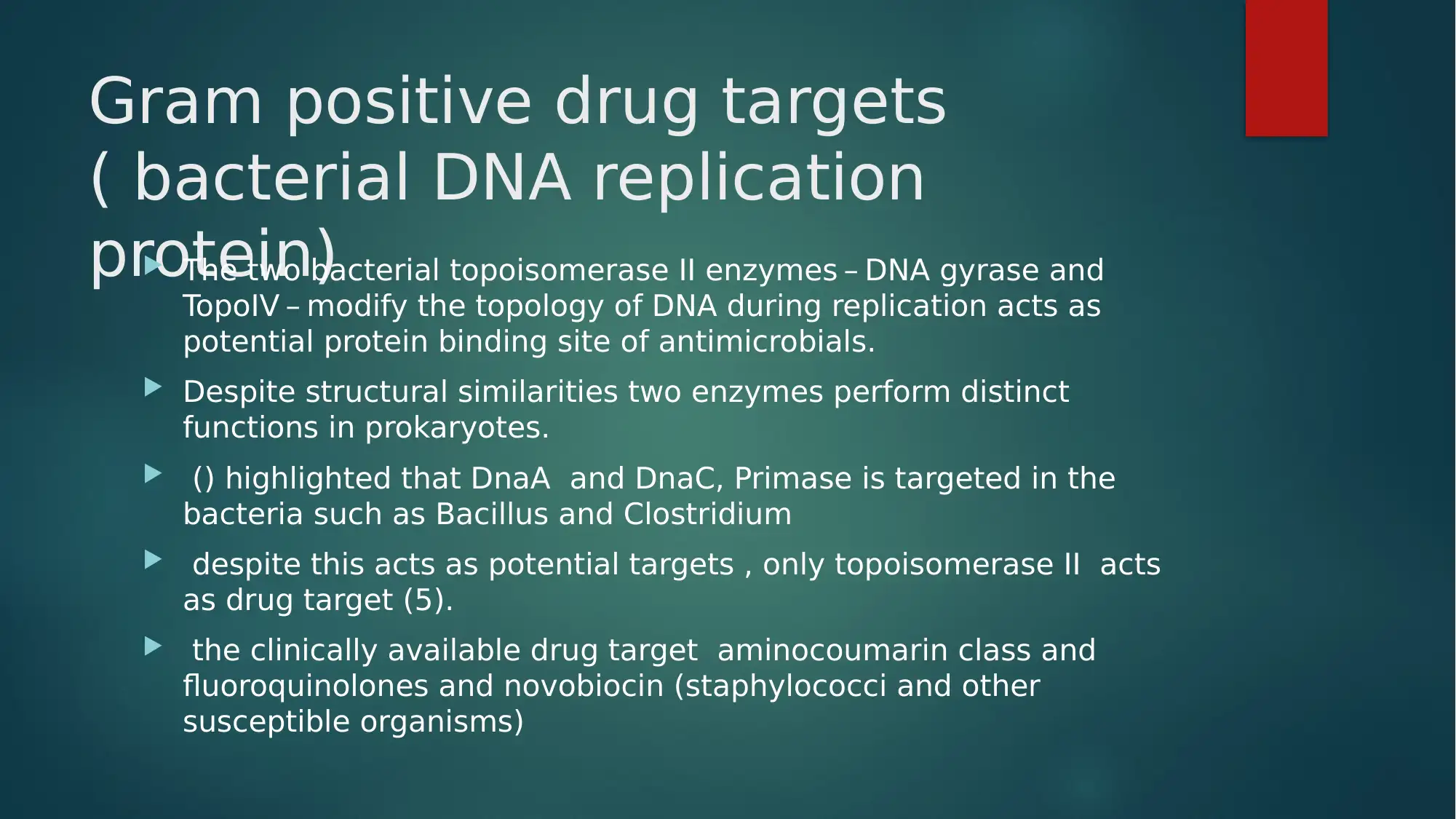The Significance of Protein Binding in Clinical Drug Development
VerifiedAdded on 2023/04/25
|33
|2486
|427
Report
AI Summary
This report discusses the importance of protein binding in clinical drug development, focusing on antimicrobial drugs and their interactions with microbial and plasma proteins. It highlights how bacterial proteins serve as drug targets, detailing specific examples in Gram-positive and Gram-negative bacteria, as well as fungi, protozoa, and viruses. The report also addresses resistance mechanisms bacteria employ against antimicrobials, including efflux pumps, target modification, and enzyme production. Furthermore, it emphasizes the significance of plasma protein binding, particularly albumin, in influencing drug efficacy, distribution, metabolism, and elimination, while considering ADME principles in clinical trials. The document also touches upon the challenges and alternative perspectives in drug development related to protein binding.

Importance of
protein binding in
clinical drug
developmentNAME OF THE STUDENT
NAME OF THE UNIVERSITY
AUTHOR NOTE:
protein binding in
clinical drug
developmentNAME OF THE STUDENT
NAME OF THE UNIVERSITY
AUTHOR NOTE:
Paraphrase This Document
Need a fresh take? Get an instant paraphrase of this document with our AI Paraphraser

Protein in microbes
Microbial proteins defines as the
protein requires for conducting
normal process of cell.
The proteins also include the
normal cellular protein resembles
to the human to conduct normal
body cycle and proteins require
for the surviving in the host (4).
examples , endotoxins,
exotoxins, leucocidine, plasma
protein, hymolysin
Figure: bacterial
protein
SOURCES: 6
Microbial proteins defines as the
protein requires for conducting
normal process of cell.
The proteins also include the
normal cellular protein resembles
to the human to conduct normal
body cycle and proteins require
for the surviving in the host (4).
examples , endotoxins,
exotoxins, leucocidine, plasma
protein, hymolysin
Figure: bacterial
protein
SOURCES: 6

FUNCTION OF MICROBIAL
PROTEIN
The function of the
microbial protein is to
help in metabolism.
To collect food from
other sources
assist in cell division(3)
to bind to the host
survive inside the host
Figure: bacterial
protein
SOURCES
PROTEIN
The function of the
microbial protein is to
help in metabolism.
To collect food from
other sources
assist in cell division(3)
to bind to the host
survive inside the host
Figure: bacterial
protein
SOURCES
⊘ This is a preview!⊘
Do you want full access?
Subscribe today to unlock all pages.

Trusted by 1+ million students worldwide

IMPORTANCE OF MICROBIAL PROTEIN
BINDING IN DRUG DEVELOPMENT
A considerate number of antimicrobial
drug such as antibacterial drug target
extracellular or intracellular protein of the
bacteria to inhibit or static the growth of
bacteria
The protein binding of bacteria also help
in reduction of deadly infections, assist in
evaluating the resistant mechanism of
bacteria which further showed the
direction of future research.
Figure: bacterial
protein
SOURCES: 7
BINDING IN DRUG DEVELOPMENT
A considerate number of antimicrobial
drug such as antibacterial drug target
extracellular or intracellular protein of the
bacteria to inhibit or static the growth of
bacteria
The protein binding of bacteria also help
in reduction of deadly infections, assist in
evaluating the resistant mechanism of
bacteria which further showed the
direction of future research.
Figure: bacterial
protein
SOURCES: 7
Paraphrase This Document
Need a fresh take? Get an instant paraphrase of this document with our AI Paraphraser

antimicrobials
Antimicrobials defined as a substance that either kills or
inhibits the growth of microorganism such as bacteria, fungi
and protozoa 8)
history:
in previous era various molds and plant extracts were used to
treat infections by some of the earliest civilisations such as
ancient Egyptians
After deaths of millions of individuals because of infections such
as such as pneumonia and diarrhea. Paul Ehrlich , the German
physicians suggested that certain chemical dyes colored have
ability to kill bacteria. Later, Alexander Fleming worked on
Penicillium notatum and accidentally discovered penicillin.
Figure:
antimicrobials
SOURCES: 7
Antimicrobials defined as a substance that either kills or
inhibits the growth of microorganism such as bacteria, fungi
and protozoa 8)
history:
in previous era various molds and plant extracts were used to
treat infections by some of the earliest civilisations such as
ancient Egyptians
After deaths of millions of individuals because of infections such
as such as pneumonia and diarrhea. Paul Ehrlich , the German
physicians suggested that certain chemical dyes colored have
ability to kill bacteria. Later, Alexander Fleming worked on
Penicillium notatum and accidentally discovered penicillin.
Figure:
antimicrobials
SOURCES: 7

History of antibiotics
Figure: History of antibiotics
SOURCES: 7
Figure: History of antibiotics
SOURCES: 7
⊘ This is a preview!⊘
Do you want full access?
Subscribe today to unlock all pages.

Trusted by 1+ million students worldwide

Protein target for antibacterial
drug development
The potential drug target for antimicrobial
proteins
Bacterial
surface
protein
Bacterial
intracellular
proteins
lipoproteins
Trans
membrane
protein
Porin
proteins
DNA
polymerase
DNA
Gyrase
drug development
The potential drug target for antimicrobial
proteins
Bacterial
surface
protein
Bacterial
intracellular
proteins
lipoproteins
Trans
membrane
protein
Porin
proteins
DNA
polymerase
DNA
Gyrase
Paraphrase This Document
Need a fresh take? Get an instant paraphrase of this document with our AI Paraphraser

Key point of drug targets in
clinical development
It should give have maximum drug effect
It should not cause side effects in body
it should be readily soluble in the body
it should not target human proteins (9)
it should not destroy by metabolic fluids of
human body(8)
it should readily thatched to the bacterial
protein4
it should have bacteriostatic or bactericidal
property
Figure: bacterial
protein
SOURCES: 7
clinical development
It should give have maximum drug effect
It should not cause side effects in body
it should be readily soluble in the body
it should not target human proteins (9)
it should not destroy by metabolic fluids of
human body(8)
it should readily thatched to the bacterial
protein4
it should have bacteriostatic or bactericidal
property
Figure: bacterial
protein
SOURCES: 7

Gram positive drug targets
(surface protein)
Transmembrane protein of gram positive bacteria act as
potential drug target. Membrane proteins are used by cells to
transduce signals into cells, transport ions and molecules, bind
the cell to a surface or substrate, and catalyze reactions.
Recent technologies allows drug conventionally to target
“undruggable” regions of membrane proteins, enabling
modulation of protein–protein, protein–lipid, and protein–nucleic
acid interactions
() highlighted that Enzymes, transporters, ion channels, and
receptors are all common membrane protein (MP) used for drug
targets
although no drug developed yet but researchers has been
conducted in the laboratories to develop drugs.
(surface protein)
Transmembrane protein of gram positive bacteria act as
potential drug target. Membrane proteins are used by cells to
transduce signals into cells, transport ions and molecules, bind
the cell to a surface or substrate, and catalyze reactions.
Recent technologies allows drug conventionally to target
“undruggable” regions of membrane proteins, enabling
modulation of protein–protein, protein–lipid, and protein–nucleic
acid interactions
() highlighted that Enzymes, transporters, ion channels, and
receptors are all common membrane protein (MP) used for drug
targets
although no drug developed yet but researchers has been
conducted in the laboratories to develop drugs.
⊘ This is a preview!⊘
Do you want full access?
Subscribe today to unlock all pages.

Trusted by 1+ million students worldwide

Possible mode of action
bind proteins within
solvated regions outside
the membrane.
A hallmark of drug
ability is a solvent-
accessible hydrophobic
pockets often acts as a
active site of enzyme
( in case of orthosteric
drugs)
bind proteins within
solvated regions outside
the membrane.
A hallmark of drug
ability is a solvent-
accessible hydrophobic
pockets often acts as a
active site of enzyme
( in case of orthosteric
drugs)
Paraphrase This Document
Need a fresh take? Get an instant paraphrase of this document with our AI Paraphraser

Gram positive drug targets
( bacterial DNA replication
protein) The two bacterial topoisomerase II enzymes – DNA gyrase and
TopoIV – modify the topology of DNA during replication acts as
potential protein binding site of antimicrobials.
Despite structural similarities two enzymes perform distinct
functions in prokaryotes.
() highlighted that DnaA and DnaC, Primase is targeted in the
bacteria such as Bacillus and Clostridium
despite this acts as potential targets , only topoisomerase II acts
as drug target (5).
the clinically available drug target aminocoumarin class and
fluoroquinolones and novobiocin (staphylococci and other
susceptible organisms)
( bacterial DNA replication
protein) The two bacterial topoisomerase II enzymes – DNA gyrase and
TopoIV – modify the topology of DNA during replication acts as
potential protein binding site of antimicrobials.
Despite structural similarities two enzymes perform distinct
functions in prokaryotes.
() highlighted that DnaA and DnaC, Primase is targeted in the
bacteria such as Bacillus and Clostridium
despite this acts as potential targets , only topoisomerase II acts
as drug target (5).
the clinically available drug target aminocoumarin class and
fluoroquinolones and novobiocin (staphylococci and other
susceptible organisms)

Mode of action :
stabilize cleaved DNA–
topoisomerase II complexes
increasing the number of
double-stranded DNA breaks
in the bacterial cell(6)
Most FQs are able to inhibit
both gyrase and TopoIV
depending on efficiencies
and bacterial species
stabilize cleaved DNA–
topoisomerase II complexes
increasing the number of
double-stranded DNA breaks
in the bacterial cell(6)
Most FQs are able to inhibit
both gyrase and TopoIV
depending on efficiencies
and bacterial species
⊘ This is a preview!⊘
Do you want full access?
Subscribe today to unlock all pages.

Trusted by 1+ million students worldwide
1 out of 33
Related Documents
Your All-in-One AI-Powered Toolkit for Academic Success.
+13062052269
info@desklib.com
Available 24*7 on WhatsApp / Email
![[object Object]](/_next/static/media/star-bottom.7253800d.svg)
Unlock your academic potential
Copyright © 2020–2025 A2Z Services. All Rights Reserved. Developed and managed by ZUCOL.




